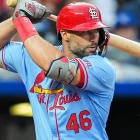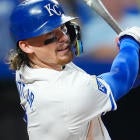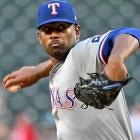
Baseball season is long. Even from one month to the next, player values can change. So while larger samples are of course more meaningful, smaller samples can reveal a reversal of trends that may have a greater say in future outcomes.
For most of the following pitchers, the outlook has improved. They appear to be getting better and make for wise investments, generally speaking. But I've also selected a couple who appear to be getting worse. You'll note the difference by the "riser" or "faller" labels.
Riser: Luis Severino
It stood to reason Severino might be a changed pitcher after nearly three seasons lost to injury, but the observed changes at the start of the year were of particular concern. He was hardly throwing his slider, heretofore considered the key to his entire arsenal. It's a pitch known for putting a strain on the elbow, so you could understand why Severino might want to steer away from it.
The decision made for an even murkier outlook, especially since those first few starts were merely so-so. Turns out it was just a blip, though. Over his past four starts, he has emphasized his slider more like he did in his heyday, about 25 percent of the time. During that stretch, he has a 1.71 ERA, 0.84 WHIP and 11.3 K/9.
Riser: Logan Gilbert
The improvement here might not be so obvious to everyone given that Gilbert had a 0.64 ERA through five starts, but his bat-missing metrics were so pedestrian during that time that I worried it might be all smoke and mirrors. Now, not so much. Over his past five starts, his swinging-strike rate is 13 percent, which is more befitting a pitcher with his talent.
Much of those gains come by way of the slider, and its improvement roughly coincides with a decision to throw his curveball more, perhaps playing the two off each other like a fastball and changeup. If nothing else, I'm now more confident in him sustaining something close to his current pace, but here's hoping the strikeout rate itself improves moving forward.
Faller: Zac Gallen
I stuck to my guns on a good number of players throughout the early-season weirdness, but one of my earliest retractions was Gallen, who I had marked as a bust out of fear his declining swinging-strike rate last year meant he wasn't entirely past his elbow troubles. But the guy we saw in his first six starts clearly wasn't the guy we saw last year (or ever, really), not only because of the 1.04 ERA but also because of the 1.3 BB/9. Even at his best, walks had always been a problem.
Since then, though, everything has gone south. In five starts, he has a 5.70 ERA, 1.65 WHIP and 4.2 BB/9. His swinging-strike rate is down to an unsavory 9.4 percent, much like last year, and my initial reservations appear as valid as ever.
Riser: Charlie Morton
It hasn't shown up in the ERA yet, but Charlie Morton's arsenal appears to be back up to form. It always rated the same in terms of velocity and spin -- his fastball still sitting at 95 mph and his curveball at a mesmerizing 3,000 rpm -- but it clearly didn't have the same bite to it, as evidenced by his 9.1 percent swinging-strike rate through 10 starts. That rate has essentially doubled over his past two starts, resulting in 20 strikeouts.
So why the eight earned runs between them? Both times, he suffered through a rocky first inning, so maybe something in his pregame work needs to change. But if he continues to miss bats like he has in his past two turns, you're ultimately going to be happy with the results. Now is about the point when he got his 2021 season on track, too.
Riser: Aaron Ashby
Wait, isn't this guy who gave up 13 hits in his last start? Yes, but 11 of them were singles, and one of the two that wasn't was an 82.5-mph triple. Bad BABIP luck, in other words, and luck in either direction generally isn't the sort of thing that sways me.
Ashby to me clearly has the makings of a front-line pitcher, featuring four pitches capable of generating whiffs and a ground-ball rate (64.2 percent) that would rank second only to Framber Valdez. And more recently, he has done a better job of limiting free passes, averaging 2.0 per nine innings over his past six appearances. If he clears that hurdle, there's no telling what he can do. He had 21 strikeouts vs. two walks in the two starts leading up to the 13-hit fiasco.
Faller: Eric Lauer
Eric Lauer's overall numbers haven't crashed too hard yet, but everything that got us so excited about him at the start of the season is back to normal. His average fastball velocity, which was 94.1 mph through his first six starts, has slipped to 93.1 over his past five. His swinging-strike rate has gone from an exceptional 14.2 percent to an embarrassing 6.0 percent during that time.
Again, his ERA was holding pretty steady until his last start, when he allowed eight earned runs in five innings, but his overall FIP and xERA are now worse than they were last year, when he was serviceable but nothing more. Maybe he can still be that at least.
Riser: Spencer Strider
Personally, I didn't need much convincing Spencer Strider was the real deal, but when his first two starts saw him deliver a 4.32 ERA and 1.56 WHIP while failing to make it through five innings either time, I'd venture to say a good many thought he was destined to return to the bullpen. But he deserved a pass for a couple of devastating non-errors made behind him in the first start and for pitching at Coors Field in the second.
The third start is where it all came together, seeing him strike out eight while walking just one over 5 1/3 shutout innings. His 13.9 K/9 are the most for any pitcher with at least 30 innings, and his 15.7 percent swinging-strike rate is the fourth-highest. You could see how this all goes very, very right for the hard-throwing rookie.
Riser: Hunter Greene
The rookie most known for his blistering fastball, which tops out at 102 mph, actually wasn't having much success with that pitch in the early going, and it forced him to rely more and more on the pitch that's actually his best, the slider. Since Hunter Greene started throwing it roughly half the time on May 10, he has a 3.20 ERA, 0.99 WHIP and 11.4 K/9 in seven starts.
It gets better. The walks that plagued him early on have gone away. He issued 2.0 per nine innings over his past five starts compared to 5.4 per nine in his first seven. His fastball has begun to play up as well, actually generating whiffs at a higher rate than the slider over his past two starts, in which he allowed a combined three hits. Because his ERA remains over 5.00, you may still have a chance to buy in on a pitcher who's on the verge of putting it all together.
Riser: Josiah Gray
Like Greene, Josiah Gray seems to have figured out that less is more with the fastball, instead emphasizing his slider in recent starts. Specifically, he's thrown it 36.1 percent of the time in his past five starts compared to 22.5 percent in his first seven. Seeing as it's his best swing-and-miss pitch, it's probably no surprise he has a 14.6 percent swinging-strike rate during that stretch compared to 11.2 percent previously.
Four of the five starts have been terrific, good for a 2.05 ERA. The other was a seven-run disaster in which he allowed three home runs to the Dodgers, keeping his overall ERA high. Still, missing more bats will go a long way toward relieving Gray's home run issues, which will always be there to some degree. Hopefully, this tweak to his arsenal is the key to improved consistency.
Riser: Trevor Rogers
As with Strider, an unfortunately timed Coors Field start conceals some of the strides Trevor Rogers has made. But if you look at the start before it and the start after it -- two of his past three, in other words -- what stands out is the effectiveness of his changeup. It had gone missing in his first eight starts this year but was the key to his arsenal last year, when he placed second in rookie of the year voting with a 2.64 ERA, 1.15 WHIP and 10.6 K/9.
The whiff rate on Rogers' changeup during those two starts was more in line with last year, topping out at 50 percent in his most recent outing. If that pitch is back on track, then the other numbers should follow, making now not the best time to quit on him.



































